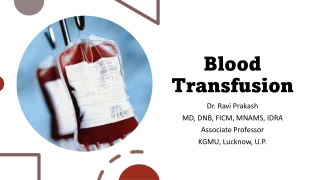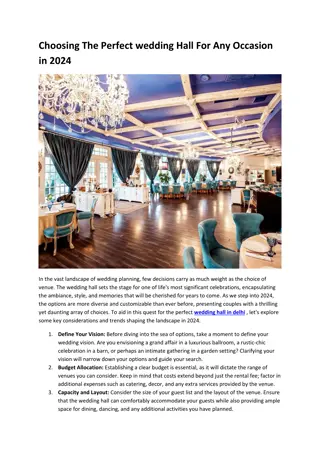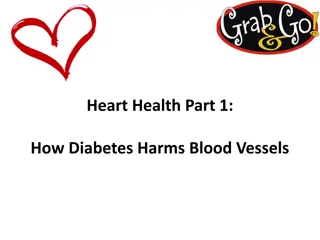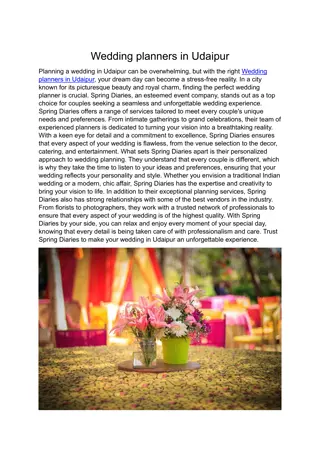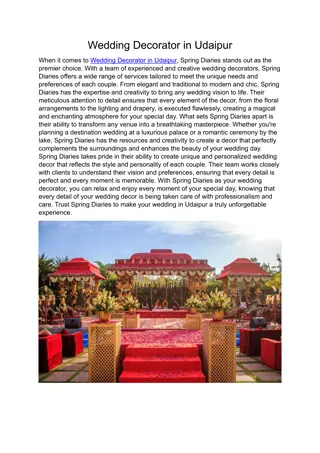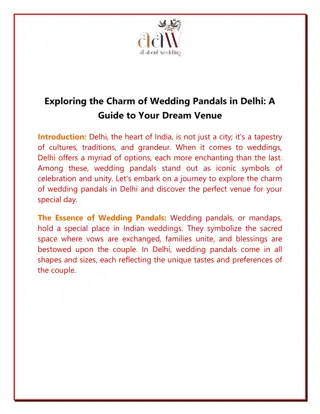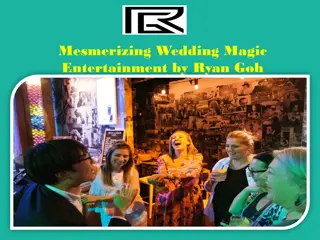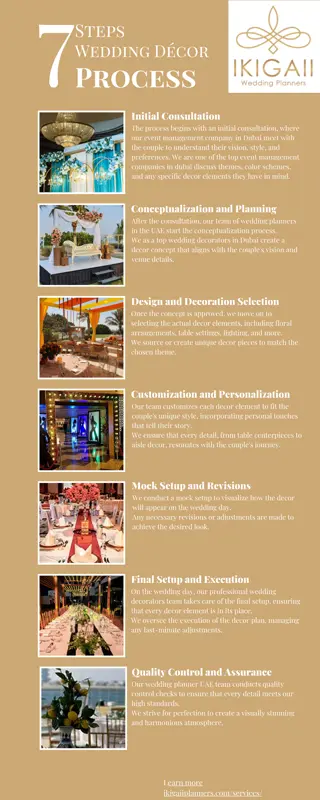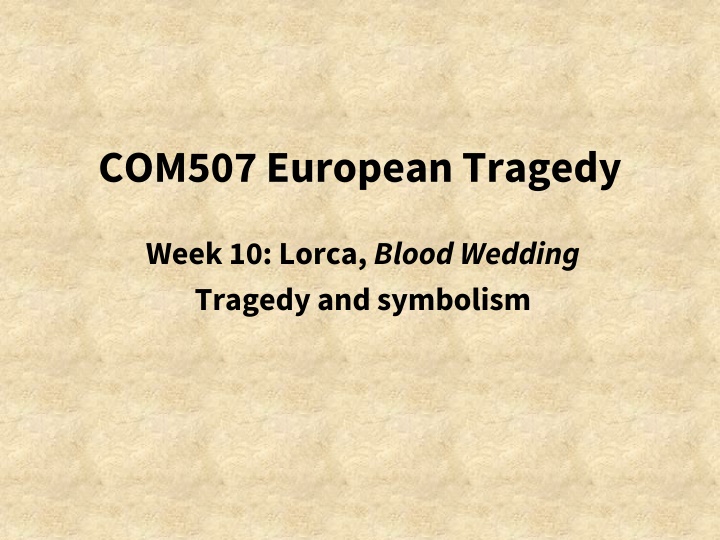
European Tragedy: Lorca's Blood Wedding - Symbolism Revealed
Explore the deep symbolism and structural intricacies in Lorca's Blood Wedding, delving into the significance of imagery, color, number, and shape. Uncover the layers of meaning behind symbols, alignments, and structures to gain a richer understanding of this timeless tragedy.
Download Presentation

Please find below an Image/Link to download the presentation.
The content on the website is provided AS IS for your information and personal use only. It may not be sold, licensed, or shared on other websites without obtaining consent from the author. If you encounter any issues during the download, it is possible that the publisher has removed the file from their server.
You are allowed to download the files provided on this website for personal or commercial use, subject to the condition that they are used lawfully. All files are the property of their respective owners.
The content on the website is provided AS IS for your information and personal use only. It may not be sold, licensed, or shared on other websites without obtaining consent from the author.
E N D
Presentation Transcript
COM507 European Tragedy Week 10: Lorca, Blood Wedding Tragedy and symbolism
Plan for the session A few words on terminology Alignments and structures: colour, number, shape Imagery and the tragic environment 1. 2. 3.
Terminology: whats a symbol? Something that stands for something else i.e. it has a meaning that goes beyond itself May be a discrete thing an object, a natural phenomenon, etc or an abstraction, e.g. a colour or number (association/opposition) We might also use image/ry to refer to the former, but not to the latter Don t overuse the terms Do you really mean that a passage contains important imagery ? Or is it simply important vocabulary, without any figurative meaning? (We might then talk about motifsrather than images/symbols) Remember that images can have very literal significance too: horse, moon, knife Figurative meaning may involve metaphoror metonymy: Metaphor involves similarity: he was a lion on the battlefield Metonymy involves contiguity: this is a prerogative of the Crown
Alignments and structures Symbols rather than images: often involve parallels / contrasts Colour: important stage directions for the settings in Act 1: 1.1 painted yellow (p. 3); 1.2 painted pink (p. 9); 1.3 pink flowers and pink ties (p. 16) Bridegroom/Mother Leonardo Bride Characters are aligned with/against others meaning is structural, not mimetic Yellow doesn t represent an important trait of the Bridegroom other colours could also be used, as long as they re organized appropriately Contrast with Act 3: colours are more mimetic Whiteness of the Moon; blue for the light it sheds at the end of 3.1 (p. 56) A white room with no shade of grey, no shadow (ibid.) in 3.2 The skein of red wool (ibid.): suggests spilling of blood, but also threads of life (associated with the Fates: recall the woodcutters role) would be sharply visible against white background on stage
Alignments and structures 2 Number: sense generated through structures Triads: three Acts; three scenes in Act 1; Mother was married for three years before her husband was killed (p. 4); 3am (pp. 18, 21) and of course the love triangle of Bride-Bridegroom-Leonardo not forgetting the trio of survivors in 3.2: Bride-Mother-Wife this suggests that triads will continue to recur over time Overall patterning: triads govern the wider world of the play, implying forces that are more powerful than humans (fate??). Also evident in Shape: importance of circular/cyclic movement Initial setting and focus on knives (1.1, p. 3) recur at the end (3.2, pp. 64-65) Dancing ( Wheel , p. 42); waterwheel (p. 33); ring (p. 46) see Anderson, 1987, p. 29: This enclosed sensation suggests the claustrophobic existential view of trapped mankind [sic], whilst the cyclical pattern relates to the process of Nature and the sense of life in death and death in life See also Rosslyn, 2000, pp. 217-18: The world of the play [ ] is one in which the circularity of the blood-feud has never been arrested, and no one wants anything better.
Imagery and the tragic environment A good starting point: Touster, 1964, pp. 19-20: The imagery throughout is that of the Earth itself, of the fundamental categories of existence: the knife and associated images from the mineral kingdom (the silver dagger stuck in the horse's eyes, the pins from the bridal wreath, the glass splinters stuck in the tongue of the Bride, the nails, the metal chain, the frost and snow, the Moon, the ashes); from the vegetable kingdom the flowers, weeds, wheat, bread with which the fathers and sons of men are identified (Man [sic] is a "mirror of the earth'"); and from the animal kingdom the man himself, inseparable from his horse; the woman associated with the serpent; the birds. The supreme image of the play is blood, with its analogue and opposite water. Both blood and water are ambivalent symbols, as are many of the images of the play that connote both life and death (the knife and the Moon, male and female symbols of fertility as well as of coldness and death; the serpent, a symbol of fertility and of treachery; the bird-the luminous dove associated with the Bridegroom, traditional Catholic symbol of the Holy Spirit, divine instrument of fecundation, and the "great bird with immense wings" that is Death). This ambivalent imagery presents the life-death opposition as a process in which the polar extremes appear as a single experience. In the moment of most intense life man [sic] is aware of his [sic] doom, and in death he [sic] becomes an instrument of life. i.e. natural processes, or basic material existence, supply images
Imagery and the tragic environment 2 Moon: nearly always a symbol of death or sterility in Lorca s work (Palley, 1967, p. 76); see also Touster, 1964, p. 26 Knife: NB various words used in Spanish (Bennett, 2002, p. 22) Sometimes has phallic connotations (e.g. p. 10 lullaby), but for the Mother knives are simply destructive (Palley, 1967, p. 77) This also reflects a general association of certain kinds of knife with death, as Lorca identified in Spanish culture (Touster, 1964, p. 26) Seeds/wheat/grain: general associations with the terrestrial sources of life in Lorca s work (Palley, 1967, p. 78) Sexual potency: p. 4; prosperity: p. 36; Blessed be the wheat, for my sons lie beneath it (p. 63) Compare the Bride s garland of orange blossom, symbolizing chastity: It s all made of wax. Everlasting (p. 37); or could it be seen as a clear reference to the unnaturalness of the union (Palley, 1967, p. 79)? Fire: symbolic of life as well as of death (Touster, 1964, p. 24), e.g. Servant s song in 2.2 (p. 34)
Imagery and the tragic environment 3 Water: 1.2 lullaby, where the horse represents Leonardo What is the water that he refuses? It may be his wife, the calm and security of his home, rejected in favor of the novia; or the scene may be that of his death in the mountains, his head resting in a stream [pp. 60-61] (Palley, 1967, p. 75) Also associated with passion: a drop of cool water / a dark river (p. 62) Can be both purifying and destructive (Touster, 1964, p. 21): It s the decent girls (p. 43; tradition of female honour suicide) Horse: autonomy and masculinity; see Palley, 1967, p. 75 Contrast (pp. 32, 34) between horse and cart independent and natural v. socially embedded and technological Blood: life as well as death A life force; a natural inclination; family ties; violence; sexual consummation v. virginity (p. 55; see note) See also Palley, 1964, pp. 77-78; Touster, 1964, pp. 21-22 Not all occurrences have been covered here you ll be able to spot further examples
Final perspectives on symbolism Symbols are often polysemous: they can mean more than one thing, and their complexity often develops over the course of the play They provide coherence across the play, especially by integrating Act 3 with the preceding Acts


